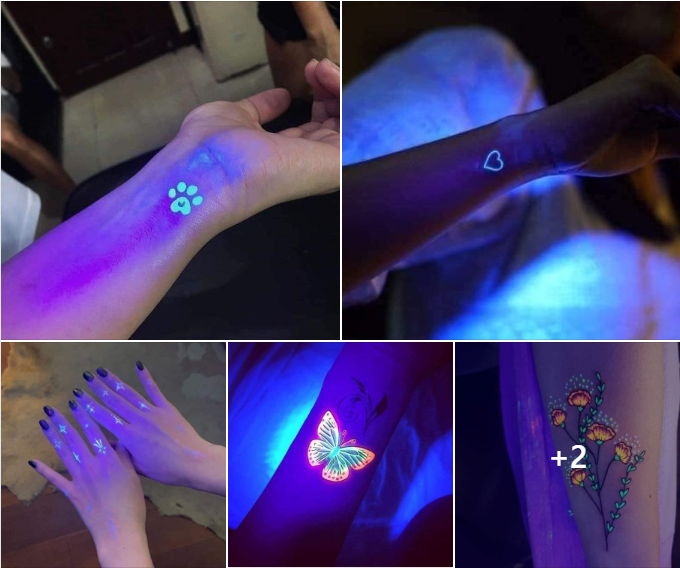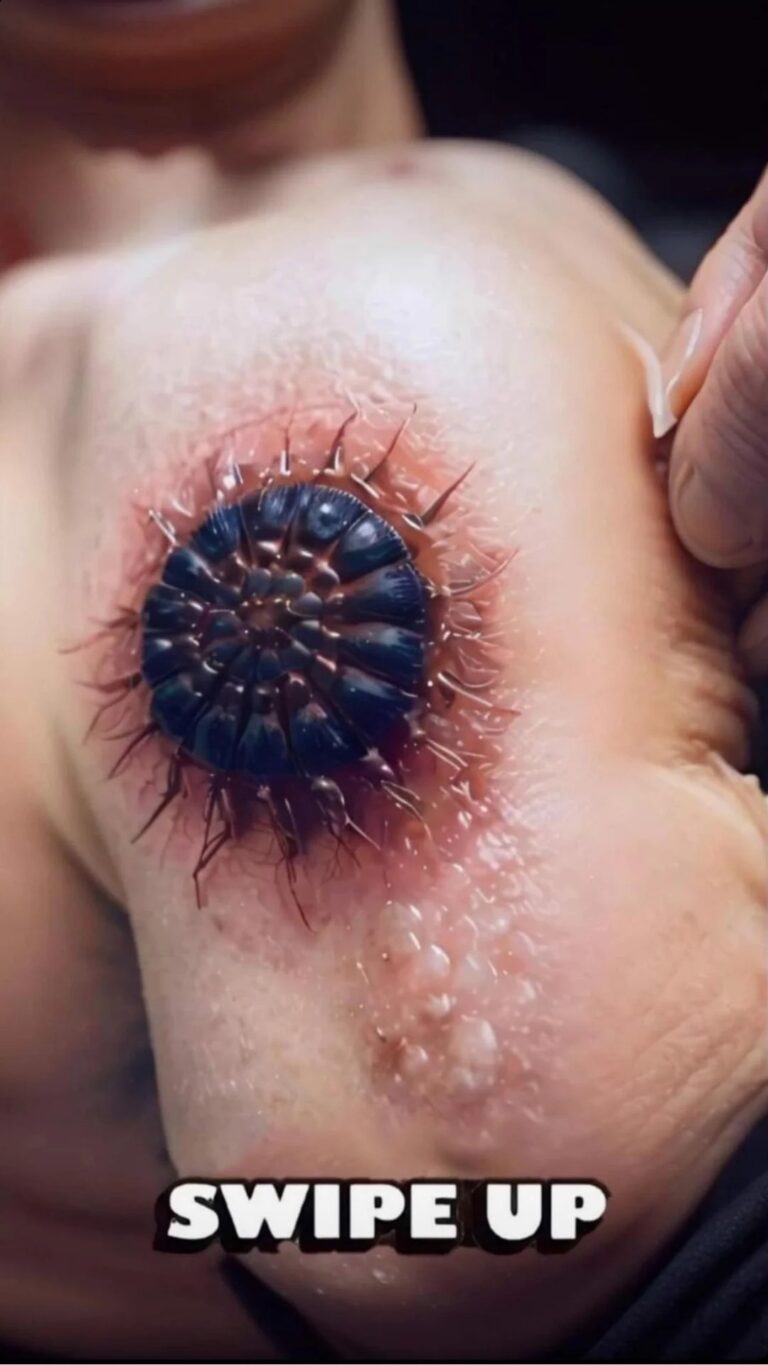Glow-in-the-Dark Tattoos: Everything You Need to Know
:max_bytes(150000):strip_icc():format(webp)/uvtattoo-ad287d078c3c43508c4f9ae830f28761.jpg)
What’s cooler than a secret tattoo only a select few know about? One that also glows in the dark. That’s right, glow-in-the-dark tattoo ink is real. And, while the tattoo style doesn’t produce an ever-glowing design (you’ll need a black light to see it), it does offer a secret way to put a vibrant spin on traditional ink. But how does it differ from a regular tattoo, if at all? We reached out to the experts for all the information on the sci-fi-turned-reality skin art.
Read on for everything you need to know about glow-in-the-dark ink, from safety to staying power and beyond.
What Are Glow-in-the-Dark Tattoos?
Glow-in-the-dark tattoos are tattoos made with vivid, fluorescent colors that are quite difficult to see in daylight. These types of tattoos don’t quite live up to their names, though: They won’t simply glow when you turn off the lights. (Science hasn’t gotten that far yet.) Instead, glow-in-the-dark tattoos generally require a black light to trigger the glow-like reaction due to the UVA light it emits.
Celebrity tattoo artist Dillon Forte says, “These types of tattoos are actually only visible under black lights. Knowing that most of us aren’t hanging out at raves these days or planting black lights all around our rooms, we probably won’t have many chances to see the tattoo light up. For your typical blacklight tattoo, the artist has to be careful not to mix standard, darker pigments too close to the zinc sulfide as it may reduce its ‘glow.'”
This style of tattooing is fairly new compared to a lot of other techniques, and it became popular in the 1990s due to the rise of the neon trend. When the style was originally developed, artists would use an ink solution containing phosphorus as well as traditional pigments. However, this technique was deemed dangerous due to phosphorus being a carcinogen that caused a number of skin conditions. Now, artists tend to stay away from ink containing the highly toxic chemical due to its dangerous nature.

Benefits of Glow-in-the-Dark Tattoos
Glow-in-the-dark tattoos offer the same expressive art form as other tattoos with the added bonus of being far less common. While you may find others sporting the same tattoo designs in regular ink, the chances decrease substantially with glow-in-the-dark styles. As we mentioned, most glow-in-the-dark tattoos only glow under a black light. So, this tattooing technique is perfect for any of these three reasons: if you don’t want to have an especially visible tattoo; if you want to be the life of the (dimly-lit) party; or if you want to add a bit of pizzaz to a regular tattoo.
Glow-in-the-Dark Tattoo Safety
Because tattoo artists no longer use ink with phosphorus to achieve the glowing effect, glow-in-the-dark tattoos are now generally considered just as safe as a normal tattoo, according to Dr. Nazarian. To replace the chemically dangerous pigments, glow-in-the-dark tattoos are now created using ink that is reactive to UV light.
“They aren’t actually phosphorus-containing true glow-in-the-dark pigments, which would not be safe,” she says. She adds that glow-in-the-dark tattoos are permanent like regular tattoos, and while some colors may change and fade slightly with time, essentially the pigment remains much like regular tattoo pigment.
It’s still important to do your research before going to get your own glow-in-the-dark tattoo. While most tattoo shops have switched to the new light-reactive ink, the presence of phosphorus is still possible. Tattoo ink, in general, is not regulated by the FDA, so there is always the possibility that specific shops or artists still use non-safe pigment. Also, most major ink manufacturers don’t readily offer a list of ingredients, and even all-natural inks could still contain phosphorus (which is a natural chemical). While you may want to ditch the safety data in favor of a more vibrant tattoo, note that phosphorus-based inks could cause intense swelling, rashes, and burning.
“My recommendation is to always ask about ingredients found in the tattoo pigment, to ensure there’s no phosphorous or any ingredients you may be allergic to,” she says. Forte agrees, “I would ask your artist before getting any tattoos like this. Knowing what’s going into your skin and body is very important.” And just as with other tattoos, you should follow strict post-care recommendations.
Dr. Nazarian recommends applying a thick layer of Aquaphor after washing the area gently every day.
Because of the uncertainty around what you’re putting into your skin, be sure you find an artist with a lot of glow-in-the-dark tattooing experience. You should also speak with your artist extensively about what ink they use. A good artist will understand your concerns and be able to put you at ease. Instead, inquire about using highly pigmented, UV-reactive ink. Such tattoos are naturally fluorescent, 100 percent vegan, and contain no additional chemicals. Getting a tattoo with UV-reactive pigment is the exact same process as a normal tattoo—it just also glows!

How Long Do Glow-in-the-Dark Tattoos Last?
Glow-in-the-dark tattoos will last just as long as regular tattoos if you are careful and intentional about choosing artists who use UV-reactive pigments. As with any tattoo, these ones will fade slowly over time but never fully disappear. It’s important to consider that if you ever find yourself in a position of wanting to cover up your glow-in-the-dark tattoo, colored ink applied on top may appear duller than expected, and the glow-in-the-dark properties of the original tattoo will no longer work.
Dr. Hayag explains that glow-in-the-dark tattoos are permanent but, “like regular tattoos, fade over time and need touch ups. The more the tattooed area is exposed to the sun, the quicker it will fade and the more dull it will be under blacklight.”
Because the pigments are much brighter, you may see more of a need to get a touch-up than with a normal black or deeper color-based designs. UV-reactive inks may even fade into different colors if exposed too much to the sun; for example, blues may fade into yellows or browns. Other than this specific issue with the colors, glow-in-the-dark tattoos are permanent and heal just like normal tattoos.

Aftercare
Care for your glow-in-the-dark addition similarly to how you’d care for a regular tattoo. Make sure to clean it well using fragrance-free soap and water, then apply a thin layer of Aquaphor or specialty tattoo after-care treatment. Listen to your artist and the aftercare guidelines they give you. If you suspect an infection, see your medical provider.
Forte says that for glow-in-the-dark tattoos he’d recommend a similar regimen of skincare creams designed or suggested for any other type of tattoo care.
Once the tattoo is fully healed, use sunscreen daily to protect it from sun damage.

Cost
While it always depends on your artist and their pricing, Forte says that pricing for glow-in-the-dark tattoos should be similar to regular tattoos but that it depends on the artist or studio. “Typically, tattoo artists bill by the hour regardless of design. If the material used for the black light tattoo costs more than standard inks, they may pass that cost on to the customer though,” he says.
The Takeaway
While glow-in-the-dark tattoos are very fun, there is still some back-and-forth between the experts on whether or not this art is 100% safe yet due to the possibility of toxic ingredients. Just like other tattoos, glow-in-the-dark and UV-reactive tattoos are permanent and should be approached with the same care and consideration as regular ink tattoos. The UV-reactive ink can also make future cover-ups more difficult.








